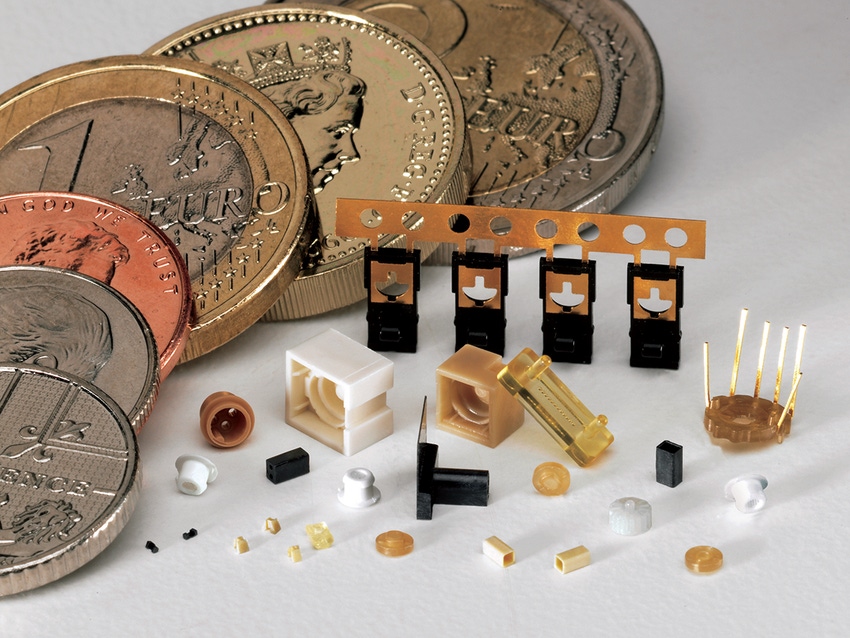Locking features are vital when working in small scales and micron tolerances. Considering them in advance will save you precious time and money.
April 10, 2019

|
Complex and critical components with micron tolerances and very little geometry to work with can pose difficult locking feature challenges (Image source: Accumold) |
Locking features are often essential when looking to overmold or insert mold one or more other components. It’s easy to forget, yet can cause a lot of rework if not caught up front. And because of the unique design considerations around micro, engineers may not realize how important this consideration is to the manufacturability and robustness of the design.
There is nothing standard or routine about a design for manufacturability (DFM) engineer’s job. As micro mold experts, we constantly work under the hood of each project, ensuring clients complete their goals without compromising project integrity. We constantly overcome challenges and act as the first line of defense for snags that are often overlooked – snags like creating a part design without considering locking features when designing for multi-component molded projects.
Typically appearing as a rivet, hole, or protrusion on a part meant to accept an over-mold or hold another part in place, if left off the final project the overall function of the part may fail with part delamination. In some cases complete separation from the substrate is likely. Since locking features provide an indirect benefit to the overall part function and project success, it’s unlikely another engineer will even notice until it’s too late, even if that engineer is familiar with the design process.
While it’s true keen micro mold DFM engineers are quick to catch this kind of issue and eager to collaborate on a solution to ensure the part will adhere during the DFM stage, this isn’t truly the best solution for OEMs.
When redesigning larger parts, locking feature challenges are quicker and easier to overcome. Complex and critical components with micron tolerances and very little geometry to work with can be a challenge, however. A redesign at this stage can add considerable design time to the project. It’s not always such a simple fix by the time it gets to DFM engineers.
RELATED ARTICLES:
By the time a DFM engineer sees the design, they may suggest the substrate be redesigned to allow for holes that can be used as locking features for the overmolded component. In other cases, the entire part design may change to accommodate the locking feature. If there is one thing every part designer must be cognizant of, it's location, location, location. Force is also a consideration.
Locking features are intended to hold the overmolded component to the substrate, so part designers must fully consider the forces the final part will be under in a real use scenario. Sometimes the forces are minimal, but other times the forces exceed the strength of the locking feature design — this is a critical step in determining robustness and how many locking features are needed.
In some cases, when a hole, post, rivet, or protrusion can't be accommodated, an undercut design can be the perfect solution to a very challenging design problem. But even when a locking feature cannot be added, however, there are still options.
Often, relying on a chemical bond between the substrate and overmolded component is a sufficient option. A bond of this class is heavily reliant on the two substrates selected and oftentimes a complete material change is required to ensure the chemical bond between materials is strong. This process has been made easier in the past decade due to the wide availability of cutting-edge materials.
Going after big projects with impossible challenges is exciting and the potential is huge, but sometimes through no fault of the designer, projects hit brick walls. Although unlikely, when part sizes or designs cannot entertain a locking feature, the materials specified cannot be changed or die locking features in the mold design can’t be accommodated there is a final resort.
While it’s true in these cases, projects have to be completely changed or scrapped, it doesn't have to be a total loss — there is a parachute specially made for designers or a project manager.
With the right partners, the risk is greatly reduced by simply bringing in your micro molder or strategic partners as soon as possible.
ESC BOSTON IS BACK! The nation's largest embedded systems conference is back with a new education program tailored to the needs of today's embedded systems professionals, connecting you to hundreds of software developers, hardware engineers, start-up visionaries, and industry pros across the space. Be inspired through hands-on training and education across five conference tracks. Plus, take part in technical tutorials delivered by top embedded systems professionals. Click here to register today! |
Devin VanDenBroeke manages the project engineering team at Accumold, an Ankeny, IA-based micro molding company. He also holds a degree in mechanical engineering from Iowa State University.
About the Author(s)
You May Also Like





